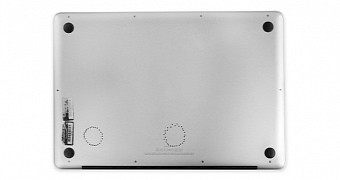Being the compact machines that they are, laptops tend to overheat. Apple’s computers are no exception to the rule. In fact, because Jony Ive doesn’t like to have many seams on his designs, MacBooks are almost sealed tight.
Apple goes to great lengths to keep temperatures low through a combination of power-efficient components and software, as well as ingeniously crafted heat sinks and vents. But there’s just so much these things can do to cool down the system. Sometimes a good old-fashioned grill is needed to let the air flow.
And that’s exactly what this iFixit programmer did after several failed attempts to cool down his MacBook Pro, which refused to work properly because of the overheating issue.
”The screen glowed. The fans blew.”
Surnamed Sterling, the iFixit programmer reveals how he and a friend decided to pull out the big guns:
“With a 1/16” bit, we drilled holes in the bottom case, under the fans (we figured out where the blades of the fan were exposed based on the dust pattern stuck to the inside of the bottom case). The speed holes worked: The boot chime rang. The screen glowed. The fans blew.”
He adds, “There’s noticeably increased airflow—when I put a piece of paper on the bottom of the computer, it sticks to the case. Its average temperature is down in the 40s and 50s, lower than it’s been since before March.”
Sterling reveals that prior to mutilating his laptop, the system would average temperatures between 90 and 100 degrees Celsius, which is enough to boil water. These temperatures are highly unhealthy for any electronic device.
Alternative repair - "reflow"
It's also possible to address overheating issues by "reflowing" the electronics, which basically means cooking the logic board in an oven for a few minutes to soften the soldering and allow it to melt back into the designated spots.
By no means should you do this without professional assistance if you're no techie.

 14 DAY TRIAL //
14 DAY TRIAL //